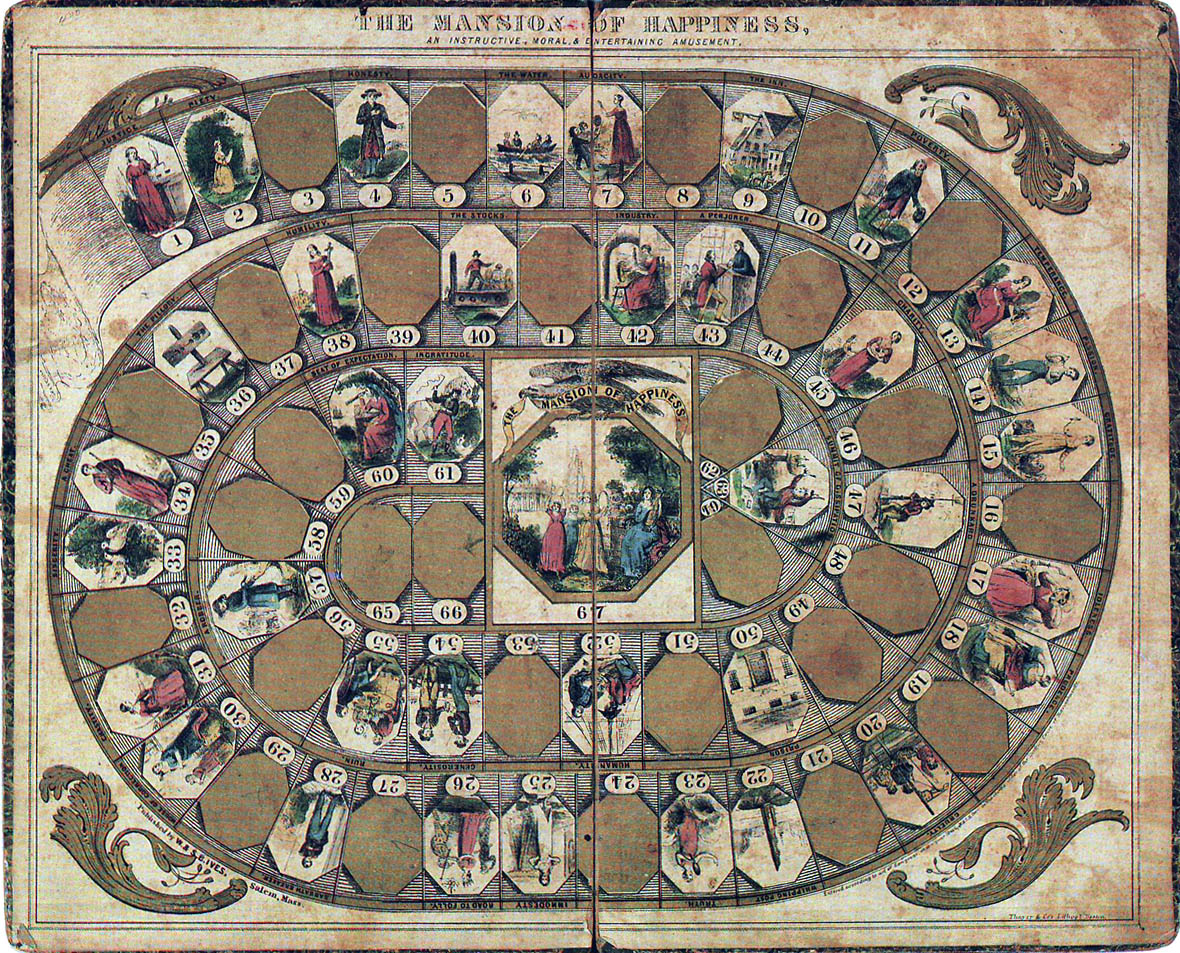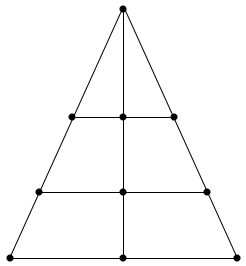|
Tiger Game
{{unreferenced, date=October 2011 The tiger game is a traditional Chinese board game. It is a strategy game for two players. One player, who plays the tiger, has only one piece. The other player has 18 men. The tiger must eat the men, who must block the tiger so that he cannot move. The game can be played with any kind of pieces that can be distinguished from one another. The board is 8×8 squares, with the addition of a square of 2×2 squares, which is called the tiger's lair. Play The men cannot take the tiger, but can only block him. The tiger, by jumping over a man, can take it, in which case the man is removed from play. The men must stay together 2 by 2 to block the tiger. In general, if a tiger eats more than three pieces, it is unlikely that men will have enough pieces to win the game. If the men do not make mistakes, but move cautiously, victory is likely. See also *Tiger and buffaloes Tiger and buffaloes is a two-player abstract strategy board game from Myanmar (for ... [...More Info...] [...Related Items...] OR: [Wikipedia] [Google] [Baidu] |
Board Game
Board games are tabletop games that typically use . These pieces are moved or placed on a pre-marked board (playing surface) and often include elements of table, card, role-playing, and miniatures games as well. Many board games feature a competition between two or more players. To show a few examples: in checkers (British English name 'draughts'), a player wins by capturing all opposing pieces, while Eurogames often end with a calculation of final scores. ''Pandemic'' is a cooperative game where players all win or lose as a team, and peg solitaire is a puzzle for one person. There are many varieties of board games. Their representation of real-life situations can range from having no inherent theme, such as checkers, to having a specific theme and narrative, such as '' Cluedo''. Rules can range from the very simple, such as in snakes and ladders; to deeply complex, as in '' Advanced Squad Leader''. Play components now often include custom figures or shaped counters, ... [...More Info...] [...Related Items...] OR: [Wikipedia] [Google] [Baidu] |
Strategy Game
A strategy game or strategic game is a game (e.g. a board game) in which the players' uncoerced, and often autonomous, decision-making skills have a high significance in determining the outcome. Almost all strategy games require internal decision tree-style thinking, and typically very high situational awareness. Strategy games are also seen as a descendant of war games, and define strategy in terms of the context of war, but this is more partial. A strategy game is a game that relies primarily on strategy, and when it comes to defining what strategy is, two factors need to be taken into account: its complexity and game-scale actions, such as each placement in a Total War series. The definition of a strategy game in its cultural context should be any game that belongs to a tradition that goes back to war games, contains more strategy than the average video game, contains certain gameplay conventions, and is represented by a particular community. Although war is dominant in strat ... [...More Info...] [...Related Items...] OR: [Wikipedia] [Google] [Baidu] |
Tiger And Buffaloes
Tiger and buffaloes is a two-player abstract strategy board game from Myanmar (formerly known as Burma). It belongs to the hunt game family. The board is a 4x4 square grid, where pieces are placed on the intersection points and move along the lines. It is one of the smallest hunt games. Three tigers are going up against eleven buffaloes. The tigers attempt to capture as many of the buffaloes by the short leap as in draughts or Alquerque. The buffaloes attempt to hem in the tigers. The game most resembles tiger hunt games (or tiger games) and perhaps can be classified as one. Examples of tiger games are Bagh-Chal, Rimau-rimau, and Catch the Hare. Tiger games usually consist of a standard Alquerque board which is a 5 x 5 square grid with several diagonal lines. Tiger and buffaloes consist of only a 4 x 4 square grid with no diagonal lines. It therefore most resembles hunt games such as Khla si ko, Len cúa kín ngoa, and Sua Ghin Gnua. The game was described by Miloš ... [...More Info...] [...Related Items...] OR: [Wikipedia] [Google] [Baidu] |
Fox Games
Fox games are a category of asymmetric board games for two players, where one player is the fox and tries to eat the geese / sheep, and the opposing player directs the geese/sheep and attempts to trap the fox, or reach a destination on the board. In another variant, ''Fox and Hounds'', the fox merely tries to evade the hounds. There are several versions known: History The game ''Halatafl'' is known from at least as early as the 14th century, and it is mentioned in Grettis saga. It probably originated in Scandinavia, as a variant of Tafl. In fact, Halatafl is still played in Scandinavia with rules similar to Tafl; see below. Edward IV of England is known to have purchased two foxes and 26 hounds to form two sets of ''Marelles'', believed to be Fox and Hounds. As Fox and Geese, the game was a favorite pastime of Queen Victoria. Halatafl ''Halatafl'' means "tail board", in Old Norse, and "tail" presumably refers to a fox's tail. As in Grettis saga, ''rävspelet'' (modern Sw ... [...More Info...] [...Related Items...] OR: [Wikipedia] [Google] [Baidu] |
Leopard Hunt Game
Leopard hunt games or simply leopard games are a group of abstract strategy games of Southeast Asian origin, similar in spirit to European fox games, although they are believed to have arisen independently. The games are usually played on a triangular board with three horizontal parallel lines (including the triangle's base) intersecting the other two sides of the triangle and a vertical bisector. Though a number of variants exist, the basic principle of the game sees one player with a single piece (the hunter) and the other playing six or seven pieces (the hunted). Players move pieces in turn along the board's lines. The objective for the hunter is to capture the opponents pieces by "jumping" over them as in checkers while the hunted seeks to corner the hunter so that it has no possible move. Regional variants include: * Len Choa * Hat diviyan keliya * Aadu puli attam The Lambs and Tigers Game locally referred as the Game of Goats and Tigers ( ta, Aadu puli aatam, te, M ... [...More Info...] [...Related Items...] OR: [Wikipedia] [Google] [Baidu] |
Rimau
Rimau is a two-player abstract strategy board game from Malaysia. It is a hunt game, and specifically a tiger hunt game (or tiger game) since it uses an expanded Alquerque board. One tiger is being hunted by 24 men. The tiger attempts to eat the men, and the men attempt to trap the tiger. Unique to Rimau (and the two-tiger variant Rimau-rimau), the tiger can capture a line of men in a single leap. There must be an odd number of men in the line, and they must be adjacent to one another. In most hunt games, the tiger, leopard, or fox is only able to capture one prey in a leap. Origins ''Rimau'' in Malay means "tiger". The men are called ''orang-orang'', the plural of ''orang'' which means "man". Rimau is played on the same board as the game Rimau-rimau, which has two tigers and 22 or 24 men. Both games share similar rules. Rimau is a hunt game, specifically a tiger hunt game (or tiger game); this family of hunt games uses an Alquerque board or a variant thereof, including ... [...More Info...] [...Related Items...] OR: [Wikipedia] [Google] [Baidu] |
Aadu Puli Attam
The Lambs and Tigers Game locally referred as the Game of Goats and Tigers ( ta, Aadu puli aatam, te, Meka puli aata, kn, Aadu Huli aata) or Pulijudam, is a strategic, two-player (or 2 teams) leopard hunt game that is played in south India. The game is asymmetric in that one player controls three tigers and the other player controls up to 15 lambs/goats. The tigers 'hunt' the goats while the goats attempt to block the tigers' movements. Trivia * This is the ancient game played in southern part of India especially in the states of Andhra Pradesh, Karnataka and Tamil Nadu. * The board is drawn on parapet inside the mahadwara of the Chamundeshwari temple atop Chamundi Betta (hill) in Mysore, Karnataka * This game helps people to develop strategy and concept of teamwork by teaching that even though weak, if united, one can vanquish the stronger enemy as a team. * This game is very similar to the Korean game of Yut. Names * '' Aadu Puli Attam'' (The Goat and Tiger Game) � ... [...More Info...] [...Related Items...] OR: [Wikipedia] [Google] [Baidu] |
Bagh-chal
''Bagh-Chal'' ( ne, ''bāgh cāl'', new, धुँ कासा ''dhun kasa'' meaning "tiger game") is a strategic, two-player board game that originated in Nepal. The game is asymmetric in that one player controls four tigers and the other player controls up to twenty goats. The tigers 'hunt' the goats while the goats attempt to block the tigers' movements. This game is also seen in southern India with a different board, but the rules are the same. This game is popular in rural areas of the country. Overview The game is played on a 5×5 point grid, like alquerque. Pieces are positioned at the intersection of the lines and not inside the areas delimited by them. Directions of valid movement between these points are connected by lines. The game play takes place in two phases. In the first phase the goats are placed on the board while the tigers are moved. In the second phase both the goats and the tigers are moved. For the tigers, the objective is to "capture" five goats to win. ... [...More Info...] [...Related Items...] OR: [Wikipedia] [Google] [Baidu] |


